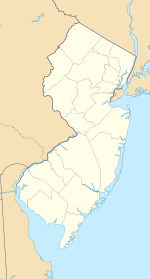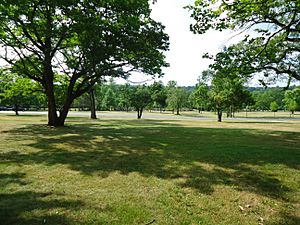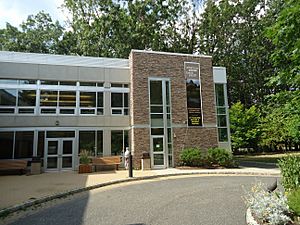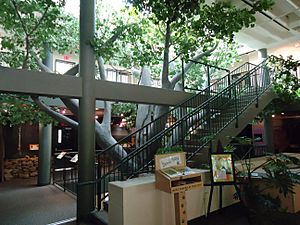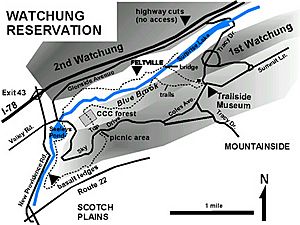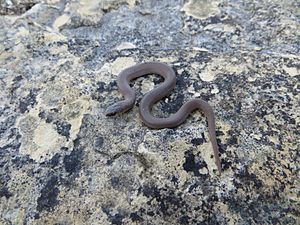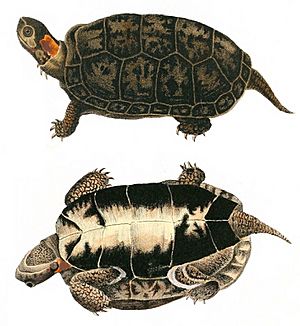Watchung Reservation facts for kids
Quick facts for kids Watchung Reservation |
|
|---|---|
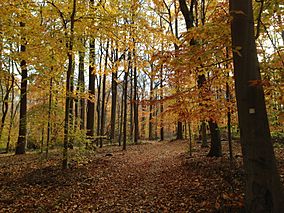
Fall foliage along Watchung Reservation Sierra Trail
|
|
| Location | Union County, New Jersey |
| Nearest city | Summit and Mountainside |
| Area | 1,945 acres (7.87 km2) |
| Elevation | 292 ft (89 m) |
| Governing body | Union County Parks Department |
The Watchung Reservation is the biggest nature park in Union County, New Jersey, USA. It's mostly found in the valley of Blue Brook, nestled between the First and Second Watchung Mountains. A dam on the creek forms a beautiful spot called Lake Surprise.
This large park covers about 1,945 acres (7.8 square kilometers). It stretches across parts of Summit, Mountainside, Berkeley Heights, Scotch Plains, and Springfield. The many trails here are popular for hiking and horseback riding. Biking on these trails is not allowed.
Contents
Exploring the Land: Geology and Fossils
The Blue Brook has carved a valley in the reservation. This valley sits between the 1st and 2nd Watchung Mountains. It was formed in softer red rock layers from the early Jurassic period, called the Feltville Formation.
The Feltville Formation is a type of rock named after the Deserted Village of Feltville in the reservation. You can see red sandstone and shale rocks along the stream and an old mill race. On the other side of the stream, there are rocks from the Orange Mountain Basalt.
The best places to see these red rocks are along the old mill race and by the stream banks. In the 1970s, a scientist named Paul E. Olsen found ancient dinosaur fossils here. You can explore the park's cool rock features by following the Ruth Canstein Yablonsky Self-Guided Geology Trail.
A Look Back in Time: History of the Reservation
Ancient People: The Lenape
The first people to live in the Watchung Mountains were the Lenape tribe. They called these mountains Wach Unks, which means 'high hills'. We know the Lenape lived here because many old campsites have been found. These sites are mostly along the rivers and in small caves in the rocks.
It's believed the Lenape loved the Watchungs because they had so many natural resources. There were plenty of fresh rivers and streams, different types of forests, and lots of fish and game. The Lenape might have also used crushed copper for their tools and decorations. The Mo-No-Pe-Nonck trail in the reservation was used by Lenape people over a thousand years ago.
Early European Settlers
There's an old, abandoned copper mine in the reservation. Some people think that people started looking for copper here as early as the 1600s. Around 1736, a settler named Peter Willcocks built a sawmill along the Blue Brook. He cleared many acres of forest to get wood for farmers.
The Deserted Village
A whole village called Feltville once stood in the woods. In 1845, David Felt built a printing factory by the brook. He then built a town on the hill above the brook to support his factory. By 1850, about 175 people lived in Feltville. After Felt retired in 1860, other businesses tried to make it work but failed. The town became empty for a short time.
In 1882, Warren Ackerman bought the property. He turned it into a summer resort called Glenside Park. Visitors could enjoy golf, boating, and horseback riding. But as cars became popular, people started going to the Jersey Shore for vacations instead. Glenside Park closed in 1916.
Art in the Village: The Murals
After Glenside Park closed in 1916, the Deserted Village started to fall apart. A local engineer named Edward J. Grassmann bought some of the buildings. He planned to use them as a club. Later, he sold them to the Union County Parks Commission.
Grassmann loved the Southwest and Latin America. He decorated two buildings in the Deserted Village to show this. He called one the "Mexican Cottage" and the other the "Indian Cottage."
It seems Grassmann convinced a famous Nicaraguan/Mexican artist named Roberto de la Selva to paint murals inside the Mexican Cottage. In the late 1920s, de la Selva spent months painting these murals. They show native Mexicans working, playing, and worshipping. These murals are very special because de la Selva was mostly a sculptor, and these are the only murals he is known to have painted.
Years after they were painted, the murals were covered with wallpaper. They stayed hidden for decades until they were found again in the 1970s. The place where the murals are in the Deserted Village was named one of the 10 Most Endangered Historic Sites in New Jersey.
Creating the Reservation
The Union County Park System was created in 1921. Soon after, this area became part of the Watchung Reservation. In 1927, a local newspaper wrote about new trails being made for horseback riding in the park.
Mysterious Stories: The Enchanted Forest
There are many stories about what people call the Enchanted or Magic Forest in the reservation. This forest is a pine tree farm with 16,000 trees planted in straight rows. It was planted in the 1930s by the Civilian Conservation Corps. The forest has white spruce, red pine, and Norway spruce trees, which are not native to the area. Native trees are slowly replacing them as the pines die.
Other mysterious tales are told about the reservation. Some stories talk about strange events and local legends. These stories might have grown from real-life sad events that happened in the area. Some people even say that 13 witches are buried under the road that goes from Watchung to Scotch Plains near the reservation.
Fun and Activities: Recreation
While there are places for fun activities, most of the 1,945-acre park is covered in forest. The park is managed to protect its natural beauty.
The most popular things to do here are hiking and horseback riding on the many trails. You can also go fishing, kayaking, and boating on Lake Surprise, Moxon Pond, and Seeley's Pond. Biking on the paved road through the reservation is popular, but biking on the dirt trails is not allowed.
Climbers sometimes visit the cliffs along the brook and Diamond Hill Road. However, climbing is technically not allowed by the county.
Play Areas
In the middle of the reservation is the Loop area. It's a big park with picnic tables and a play area called "'The Loop Playground.'"
Trailside Nature & Science Center
The Trailside Nature & Science Center was built in 1941. It's located at the southern edge of the park in Mountainside. It is the oldest nature center in New Jersey.
Demonstration Gardens
The Rutgers Master Gardeners of Union County (RMGUC) are volunteers. They help with gardening, caring for the land, and plant therapy services in Union County. Their main office is in Westfield. Their Demonstration Gardens are in the Watchung Reservation, next to the Trailside Museum. These gardens have different themes, two flower-cutting gardens, a Berry Patch, herb gardens, and even a Harry Potter Garden. They also have a Community Sharing Garden where they grow vegetables to donate.
Watchung Stables
The county owns Watchung Stables. They are located in a large cleared area at the eastern end of the park. This area was cleared in the late 1950s when the U.S. Army built a Cold War missile base here. The stables now offer 26 miles of trails for horseback riding.
Hiking Trails
The Watchung Reservation History Trail is a six-mile path that takes you through different historical spots in the park. In October 2017, the county released a new interactive map for hikers. This map helps people find their way and report any problems on the trails.
Nature's Home: Ecology
Watchung Reservation is a balanced natural area, mostly covered by beech-maple-pine forest.
Native Plants and Animals
Here are some common plants that naturally grow here:
- American beech
- Sugar maple
- White pine
- Black birch
- Spicebush
- Poison ivy
And here are some common animals you might see:
Plants and Animals Not From Here
Because the reservation is in a very populated area, some plants and animals that are not native have moved in. These are called invasive species. Common invasive plants include:
- Multiflora rose
- Japanese barberry
- Japanese knotweed
- Garlic mustard
Common invasive animals include:
- Red-eared slider (a type of turtle)
- European starling (a bird)
Species That Are Gone
Some native species used to live in the reservation but are no longer found there. These include:
Scientists believe the bog turtle disappeared from the reservation because its natural home was damaged.
The Blue Spotted Salamander
The Blue Spotted Salamander is an endangered species in New Jersey. There have been reports of it living in the Watchung Reservation. However, it's not certain if this salamander still lives there today.
Special Springs and Salamander Homes
The Army Corps of Engineers studied the unique natural springs in the reservation in 1981. These springs provide a home for six different types of salamanders.
These springs are very old and are some of the only natural, undisturbed springs left in the area. Most springs have one to three types of salamanders that live their whole lives nearby. Finding more types of salamanders means the springs have been stable for a very long time. The Four-toed salamander is a rare species, and its presence makes these springs special. The Long-tailed salamander also shows how stable these springs are, as it uses both the underground and surface parts of the springs. The reservation is the only place outside of Sussex County where these salamanders are known to live.
No other group of springs in New Jersey seems to have all five salamander species found in the reservation. There have also been reports of the Blue-spotted salamander being seen in these springs.
Challenges and Changes: Environmental Concerns
Land Use by the Government
Even with strong local protests, the government has used land in the reservation twice for its own needs. The first time was in the late 1950s. The U.S. Army built a Nike missile base there. It was used from 1957 to 1963 to protect the skies over New York City. Today, this site is where Watchung Stables are located.
A more lasting change happened in the 1980s. After years of legal battles and public protests, the New Jersey Department of Transportation got approval to build I-78 through the northern edge of the reservation. Special wildlife crossings were built to help animals move safely between the two parts of the reservation that were separated by the highway.
Mountain Biking Discussion in 2017
In 2017, there was a local debate about allowing mountain biking in the Reservation. Mountain biking groups wanted to create new bike trails.
Environmental groups and hikers were concerned. They said that the county had not been open about working with cyclists. They worried that no environmental studies had been done. They also pointed out that hiking groups had not been asked for their opinions. They felt the county moved too quickly to hire a company to plan new bike-only trails.
More to Explore
- Warinanco Park in Roselle
- Rahway River Parkway
- Union County Park Commission Administration Buildings
- Passaic River Parkway
Images for kids
-
Lake Surprise, viewed from WR Tracy Drive
-
Lake Surprise Boat Launch, viewed from WR Tracy Drive


